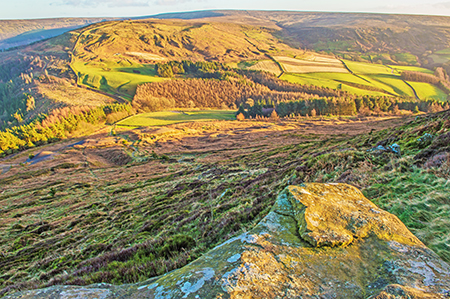 Our guest today is Mallory Jackson, author of The Penwyth Bride, a haunting paranormal romance set in 18th century Cornwall, now available on Kindle and Nook.
Our guest today is Mallory Jackson, author of The Penwyth Bride, a haunting paranormal romance set in 18th century Cornwall, now available on Kindle and Nook.
Mallory’s fascination with gothic romance started when she read Jane Eyre as a teen and it never let up. She says “I’m a huge fan of heroes who have a dark secret. For some reason, I think that’s sexy. I like writing about heroines who have a few secrets of their own.”
Mallory also writes young adult fiction, fantasy, historical romances and paranormals. She’s written novels under a variety of pen names, but historical romance is her first love. She adores research and finding obscure facts, because for her those overlooked tidbits can become fodder for a novel. “Don’t get me started about the East India Company,” she says. “I can bang on about them for hours.”
Mallory is a West Coaster who has learned to love the seasons and bitter cold winters of the Northeast, where she currently lives with her husband, daughter and a horribly spoiled cat.
How did you think of writing this particular book? Did it start with a character, a setting, or some other element?
At the time I started writing The Penwyth Bride (2001), I’d been having a love affair with traditional gothic romances. You know, books written by authors such Virginia Coffman, Mary Stewart, and Daphne DuMaurier. Those authors wrote with incredible precision and detail. Their heroines were usually plucky innocents and their heroes magnetic and tortured by a dark secret. I wanted to write a historical romance that took these classic elements and updated them for today’s reader, with plenty of sensuality and a dash of magic.
I’d also just finished watching the classic BBC miniseries Poldark with its emphasis on interpersonal family drama with a ton of drama and angst, and I wanted to capture that mood as well.
Finally, I wanted a story set in the 18th century. It was an interesting time where superstition and reason were butting heads with each other. I wanted to explore the tension between the two points of view. On a shallow note, I also really like the 18th century’s ambiance – fashion, music, preoccupations.
It wasn’t until I’d finished the manuscript and my agent at the time started shopping it around that I learned that a) publishers weren’t interested in a historical romance with classic gothic elements and b) weren’t keen on family dramas and c) didn’t like the fact that my heroine was a witch. Historical romances at the time were heavily “duke” oriented, set mostly in the first 50 years of the 19th century, and with characters that fit a specific framework. Happily the publishing situation is different now. Very.
Tell me more about your characters.
Much like the 18th century, Persia Eames is a woman caught between two worlds where the old superstitions and new focus on reason and “enlightened” thinking are in constant friction. Her father was a landed squire while her mother was a witch who was killed by the villagers. She’s trapped between these dual heritages and is struggling to find her own place in the world. She’s under constant danger of being unmasked as a witch, while at the same time she’s also considered a rich marriage prize. She’s sent to Cornwall for an arranged marriage. But she meets Roger Penwyth, a moody troubled man with secrets of his own, and is both repelled and drawn by him. Unfortunately he’s not the man she’s been sent to marry. So she’s got a lot to deal with.
Roger Penwyth also has a lot to deal with. He’s a loner on the outs with his extended family, the Penwyths. The rift widens when he meets Persia and falls in love with her. But she’s intended for his cousin who is handsome, charming and has everything going for him— the sort of man every woman dreams of, and the sort of man he isn’t—and he knows this. Roger is also carrying a dark secret that torments him. But his passion for Persia pushes him to risk everything, including his life.
Did you run across anything new and unusual while researching this book?
I’m a research junkie and I immersed myself in Cornish lore and legends, which I wove throughout the story. I found the Cornish traditions fascinating, both brutal, beautiful, and layered from centuries of storytelling. They seemed like an oral record of what we would call magic, which I used to inform the plot.
What was your publishing journey like, and what advice to you have for other writers?
The Penwyth Bride languished for quite some time. This book had been rejected by everyone. I’d get quite lengthy rejection messages from editors who said the writing was gorgeous, the plot compelling, and the characters wonderful – but they were passing on the book because it “wasn’t quite right for their lists”. After a year of rejections, my agent and I stopped the subbing process and I moved on.
Then, I sort of forgot about it. But a few months ago, my critique network started encouraging me to consider digital publishing. They remembered the book and how much they loved it. With encouragement from writers like Elena Greene, who generously blurbed my book, I took the digital publishing plunge. I figured if even just a few readers discover the story and it entertains them, the book wasn’t written in vain.
My advice to other writers is if they have a project that had been rejected because publishers were too risk-averse to buy their book back in the day to go ahead and publish their book themselves. Readers are comfortable with e-books now and are eager for good stories. Just make sure your story is the best it can be and that the editing is flawless.
What do you think is the greatest creative risk you’ve taken in this book?
The greatest risk I took was to write a story that pleased me and not the marketplace. I’d written a paranormal gothic historical romance with flawed characters who weren’t titled nobility and who had priorities that weren’t what publishers wanted at the time. So often novelists were constrained by the need to fit a certain commercial imperative because they didn’t want to spend a year writing novels they knew wouldn’t sell. Editors wouldn’t buy books that didn’t fit certain checkmarks. Digital publishing has completely blown this away, and now writers can write what they want and find ways to get it to readers without having to go through the traditional publishing gatekeeper. And the cool thing is that readers are responding. I think now there’s more variety than ever in historical romance, even among traditional publishers because readers have demonstrated that if you give them choices, they will respond positively.
What are you working on now?
I write under a variety of nom de plumes so right now I’m finishing a commission. But as soon as that’s off my plate, I’m returning to historical romance and another gothic story set in late 18th Brittany France.
I enjoy your use of first person, a point of view that emphasizes the gothic heroine’s vulnerability and the hero’s mystery. Would you share an excerpt?
He would have been sinfully handsome if not for two frown lines scoring between gilt brows, and a mouth downturned in a moody glimmer. Guinea gold hair, wild before, had been wrenched back, and he had shrugged carelessly into a coat tailored from expensive claret-colored Bristol cloth frogged with silver filé buttons.
He must have ridden like Lucifer to arrive ahead of me, I thought, and when I told myself to have done with the satanic metaphors, he himself roared:
“What the devil do you mean standing there while this lady has fallen?”
If his features were handsome, his voice was doubly so, the burred timbre as arresting as the first sip of amber malt.
I blinked into a gentleman’s neckcloth; a small tear rent the priceless lace fall. Farther up, eyes fiery with anger blurred inside a sudden smarting of tears in my own.
Faintly I heard the hired coachman’s stammered reply, and a respectful mutter wrenched from Hazel. The hard hand pinned my arm while he made a few more choice comments in that velvet whiplash voice, sending Hazel scurrying into the inn and Coachman Bobbet fawning like a cur. Then he turned his attention to me.
A chill of premonition furred the back of my neck.
“Are you Damon Penwyth?” I blurted.
It must have been imagination that made me see a flash of something like furious despair lighting the strange green eyes, the color of night mist running over a sailor’s moon, because in the next instant they stared down at me as opaque as slate.
“No. You’ll be relieved to know that I am Roger Penwyth.”
That voice.
I shivered. A lilt of indifference edged the creamy cadence as if the speaker found life not worth the effort. “Roger?” I repeated stupidly.
“Damon’s cousin. Go into the inn and set yourself aright. You can walk? Good. I’ll be with you shortly for I am come to fetch you.”
I made no move. He raked me again with those queerly blank eyes that missed nothing, and then, with a slight start, he noticed that he still imprisoned my arm securely under his fingers. He dropped it, clenching his fist before walking away, the chink of the spurs marking his gait. Beyond him, the black-and-white horse was tethered like any ordinary beast to a tiny tumbled-down cairn of rock, lipping at sparse blades of grass.
My eyes followed Roger Penwyth’s retreating back in bemusement. The flame that had ignited those features when I first saw him had been banked. He now appeared sullen rather than bitter, I thought, morose rather than ferocious. He moved with the grace of one who spends his life out-of-doors, except for a hunching of shoulder, Prometheus-like, away from the flapping vulture. Well, the heart must be protected, mustn’t it?
Thanks, Mallory!
Questions or comments for Mallory? Be sure to comment for the chance to win a Kindle or Nook edition of The Penwyth Bride!
Void where prohibited. You must be over 18. No purchase necessary. Post your comment by midnight EST on January 29. I will post an announcement on Monday, January 30th, so please check back to see if you have won.












